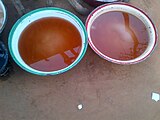Burukutu
Burukutu is an alcoholic beverage, brewed from the grains of Guinea corn (Sorghum bicolor) and millet (Pennisetum glaucum).[1] The alcoholic beverage is often produced in Tropical African countries such as Nigeria, Togo, Kenya, Ethiopia, and Burundi as one of the major traditional and local alcoholic drinks. It is commonly consumed in Northern Guinea savanna region of Nigeria, Ghana, Togo, and Republic of Benin.[2]
Production
[edit]Burukutu production has many processes depending on the African country in particular or the ethnic regions, but five basic stages have been known to be consistent all through. (Daniel, 2022). The five basic stages include: steeping, malting, mashing, fermentation, and maturation.[3] The production begins by malting, which involves the conversion of the Guinea corn or millet grains into malt and this takes place on a malting floor.[4] This process is followed by steeping, which involves the soaking of the grains in water for at least three days to allow the grain to absorb moisture and to begin to sprout.[5] When the grain has absorbed enough moisture, it is transferred to the malting floor, where it is constantly turned over for around five days while it is air-dried.[6] This procedure is followed by mashing in which the milled grain known as the "grain bill" (malted grain) is mixed with water known as "liquor" and heating the mixture.[7] This process allows the enzymes in the grain bill to decompose the starch in the grain into sugars (maltose) to form a wort.[8] The product is allowed to ferment using the sugar fungi form of yeast and allow maturation for 2 days or 48 hours.[9]
In Nigeria, particularly in Kebbi state, Guinea corn is used in place of millet or sorghum in other places due to its sweeter taste and thicker consistency. Malting proceeds and the corn is grounded. The grounded corn is mixed with water and the solution homogenised. The solution is left to ferment for a day or two depending on how well organoleptic properties and fermentation process are considered. The fermented corn is cooked and drained into another bowl when cooled. Adjuncts like Garri can be added but part of another batch of the grounded corn called a greul is added to introduce wild strains from malted corn and give a consistent flavour. The gruel and cooked fermented corn are mixed together and boiled once more. Burukutu is cooled, the next day and served to customers. Overall, the process of Burukutu production takes a period of 7 days so local producers have a batch fermentation system to keep up with their growing consumers in the North (Daniel, 2022).
Gallery
[edit]See also
[edit]- Umqombothi, Chibuku and Munkoyo or 'Ibwatu' in Zambia.
References
[edit]- ^ Thomas-Emeagwali, Gloria (1992). The historical development of science and technology in Nigeria. Edwin Mellen Press. ISBN 9780773492141. Retrieved June 30, 2015.
- ^ Solieri, Laura; Giudici, Paolo (29 August 2009). Vinegars of the World. Springer. ISBN 9788847008663. Retrieved June 30, 2015.
- ^ "Fermentation of Sorghum Using Yeast (Saccharomyces cerevisiae) As a Starter Culture for Burukutu Production". archive.org. Retrieved June 30, 2015.
- ^ "Journal of Institute of Brewing". books.google.co.uk. 2002. Retrieved June 30, 2015.
- ^ Thomas-Emeagwali, Gloria (1993). African system of science technology& art:The Nigerian experience. Karnak House. ISBN 9780907015765. Retrieved June 30, 2015.
- ^ Ray, R. C. (10 January 2006). Microbial Biotechnology in Agriculture and Aquaculture. Taylor & Francis. ISBN 9781578084432. Retrieved June 30, 2015.
- ^ Alimba, J. O. (2003). Socioeconomic consequence of technological change of Rural. African Technology Policy Studies Network. ISBN 9789966916327. Retrieved June 30, 2015.
- ^ "Chemoreception abstract". books.google.co.uk. 1988.
- ^ Maisamari, Auta (2003). "Southern Kaduna:a people misunderstood". books.google.co.uk.




